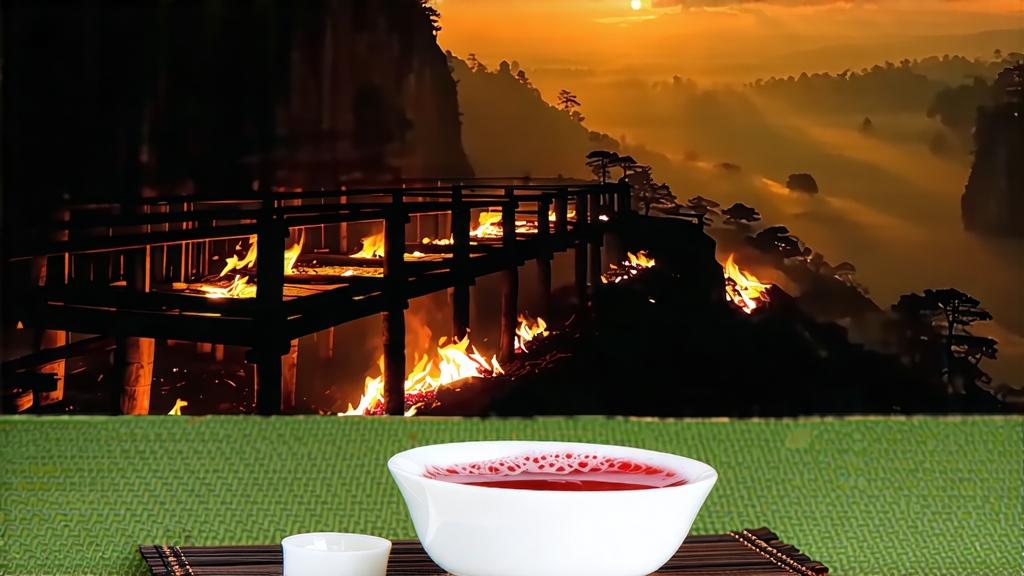
Long before Assam, Ceylon or Darjeeling entered the lexicon of tea drinkers, a small village in the Wuyi Mountains of China’s Fujian province was already sending fragrant, smoky black leaves downriver to the port of Xiamen and onward to Amsterdam and London. Those leaves were Lapsang Souchong, the earliest style of black tea ever documented, and the prototype that taught Europe what “black tea” could taste like. Today, when sommeliers speak of terroir-driven Chinese hong cha, Lapsang Souchong remains the boldest, most polarizing, and—paradoxically—the most misunderstood ambassador of the genre.
History: From Ming-Era Mist to London Drawing Rooms
Local legend claims the smoke-drying technique was born in 1646, when Qing troops forced tea farmers to flee their homes in Tongmu village. Returning after the soldiers left, the growers found the fresh leaves they had left behind had oxidized overnight. To salvage the crop they rushed the oxidation over open pinewood fires; the resulting tea, dark and aromatic, fetched higher prices than the original green tea ever had. Dutch traders christened it “bohea,” a corruption of “Wuyi,” and by 1669 the British East India Company was listing “Souchon” (small-leaf) among its most valuable commodities. Catherine of Braganza’s dowry chest, carried to the court of Charles II, is said to have contained a tin of Lapsang Souchong, sealing the tea’s reputation as the beverage of kings. Centuries later, when Scottish botanist Robert Fortune smuggled tea plants and craftsmen to India in 1848, the processing notes he carried were copied directly from Tongmu workshop ledgers—proof that the world’s entire black-tea industry traces its lineage to this pine-scented origin.
Micro-Terroir: Where Rock, River and Fog Converge
Tongmu lies inside a national nature reserve at 27° N latitude, hemmed by 1,500-metre granite cliffs that trap cool, moist air from the Chongyang Brook. The mean annual humidity hovers at 85 %, ideal for the slow withering that precedes smoking. Soils are acidic, rich in quartz and humus, forcing the tea bushes—predominantly the small-leaf cultivar Xiao Ye Zhong—to drive roots deep into fissures, concentrating amino acids and volatile oils. Because pesticides are forbidden inside the reserve, insect bites naturally trigger the plant’s defense compounds, adding a subtle honeyed note that balances later smoke.
Two Faces of the Same Leaf: Traditional Smoke vs. Contemporary Fruit-Aroma Styles
Purists divide Lapsang Souchong into two families. The classic “Zheng Shan Xiao Zhong” is crafted entirely inside Tongmu using pinewood fires; its export version, known abroad as “smoked Lapsang,” delivers an assertive campfire bouquet. Since 2005, innovative Tongmu masters have also created an unsmoked variant called “Wu Xun Xiao Zhong,” dried only with warm air to foreground natural fruit and malt tones. Both share the same cultivar and oxidation parameters, but diverge at the final firing stage, offering modern drinkers a stylistic choice between tarry nostalgia and silky sweetness.
Craft: A Choreography of Fire, Wind and Time
Plucking begins at Qingming when buds unfurl to one leaf and a half. Shoots are cradled in bamboo baskets and carried downhill within two hours to prevent compression bruises. The first act, yao qing (“rock shaking”), is still performed on bamboo trays set over shallow charcoal pits; gentle tossing for 6–8 hours initiates enzymatic oxidation while evaporating surface moisture. Once leaves turn chestnut-brown and emit a ripe-apple fragrance, they are loaded into rectangular wooden barrels lined with hemp cloth; here they rest 3–4 hours at 28 °C, deepening color to mahogany. The critical smoking follows: fresh-cut Masson pine is split into finger-thick strips, ignited at the mouth of an earthen oven only long enough to produce thick white smoke, never flame. Tea is spread on multi-tiered bamboo racks 1.5 m above the smouldering wood; every 20 minutes the master flips the leaves by hand, ensuring even absorption of guaiacol and syringol, the phenols responsible for the signature